Witness Today Says There Was No Plan to Smash the Vietnamese
Today, February 3 2016, witness Meas Voeun concluded his testimony. He stated that he had been misunderstood yesterday and that there was no plan to “smash the Vietnamese” between 1975 and 1979. Next, witness In Yoeun took the stand. She was scheduled to testify on the treatment of the Vietnamese, but claimed she could not remember anything about this. It seemed that there had possibly been some confusion in the DC-Cam statement that the lawyers relied on and that her husband or neighbor should have testified instead. She was able to give some evidence on forced and arranged marriages.
Treatment of the Vietnamese
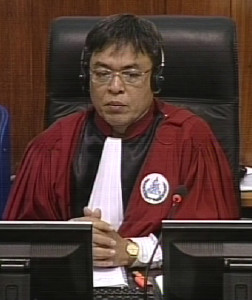
Trial Chamber President Nil Nonn
At the beginning of the session, the President announced that Meas Voeun would conclude his testimony today, after which In Yoeun would be questioned. The Trial Chamber Greffier confirmed the presence of all parties, with the exception of Pich Ang, who was absent for personal reasons. Nuon Chea followed the proceedings from the holding cell. The floor was then given to the Co-Prosecutors. The President reminded the witness to listen to the questions and the Co-Prosecutors that the questions should be precise.
Senior Assistant Prosecutor Vincent de Wilde started his line of questioning by turning to the topic of the plan of the Democratic Kampuchea government to be “smashing the Yuon” and that the the Yuon did not have the right to live in Cambodia anymore. At this point, Defense Counsel Ms. Guissé intercepted and requested the question to be rephrased, since she had not heard the witness talk about a plan by the government. Mr. de Wilde rephrased his question and asked the witness where this plan stemmed from. The witness answered that there was a conflict between the Yuon government and the Democratic Kampuchea force. “There was no plan to […] smash them”, he corrected his statement from yesterday, and said that the plan was to gather the Yuon in order to isolate them from the “external Yuon”.
Mr. de Wilde read yesterday’s statement, in which he had said that those Vietnamese who did not leave the country had to be smashed.[1] Again, Ms. Guissé objected, stating that the witness had referred to the period of 1970 until 1975. Mr. de Wilde inquired about the time period and asked whether these were instructions in the East Zone. The witness answered that he referred to the period of 1970 “when there was fighting going on”.
Mr. de Wilde said that the question yesterday had clearly referred to 1975 until 1979. International Nuon Chea Defense Counsel Victor Koppe interjected and said that the questions had not been clear. The objection was overruled. The witness answered that they “had to be gathered up and sent to the upper echelon”, since they were not allowed to live in Kampuchea, but there was no plan to smash them. He would collect them and then send them to the upper level. He received this order from Ta Soeung.
When Mr. de Wilde asked whether he heard Nuon Chea, Son Sen, Ta Mok or Khieu Samphan talk about a plan to smash the remaining Vietnamese people, he denied having met them. When he went to Koh Kong, there were no civilians. They captured the Yuon who went to their area and sent them to the divisional headquarters.
He said that he was stationed in Koh Kong after 1975. However, he lived along the border. He confirmed that he was stationed in Koh Kong when he received the instructions.
Meetings and reports
Mr. de Wilde inquired whether the West Zone had to report to the Center in relation to the internal and external enemy.[2] He said that the Zone made the report to the Center. “I only knew what happened in my division.” He would attend a meeting once every six months.
In his Written Record of Interview, he had said that he would attend a meeting at the zone level every three to four months.[3] Mr. Voeun said that he would sometimes not attend the meetings, “since the road conditions were bad.” He would be invited once every three or four months, but he was not always able to attend.
According to the witness, the content of the meeting was about
- The border of the country
- Agricultural production
- “The tricks and the plans of the infiltrated enemies”, which hindered the development of the country
In some meetings, the yields of rice production were discussed. He sometimes made the report about the agricultural production, while some other reported on their divisions.
Mr. de Wilde asked leave to show a monthly report of July 1978 to the witness.[4] Mr. Koppe interjected and said that “of course I knew that this was coming”, and explained that the witness had said in 2012 that he was gone already by that time. Mr. de Wilde answered that based on the answers the witness had given yesterday the question was appropriate. The objection was overruled. When Mr. de Wilde gave the relevant references, Ms. Guissé objected and said that the witness should first be asked whether he remembered such a document.[5] The President instructed the Co-Prosecutor to ask open questions first. Mr. de Wilde asked whether he ever received such reports, which the witness denied. “There were no reports about what you described in the meetings. And when I was working in the West Zone, I have never received that reports.” Mr. de Wilde confronted him with the report nonetheless, in which it had be said that a hundred Yuons of all ages had been smashed and asked him how he would explain this. Mr. Koppe objected again, saying that this had been dealt with in 2012 and was repetitive. Ms. Guissé also objected and elaborated further that the witness could only testify on matters in his area. The objection was overruled and Mr. de Wilde repeated his question. The witness answered that he was not aware of the report that had been described. He said that the Zone never sent him reports in response to his report. Thus, he did not know what the content was of the report after having submitted his own reports to the Zone.
Kampong Chhnang airport
Mr. de Wilde then inquired whether he knew that there was a construction site for an airport in Kampong Chhnang. Mr. Voeun confirmed this. However, he himself did not go there. He did not know whether it was under the control of the Center or of the West Zone. Mr. de Wilde wanted to know whether soldiers had been sent to Kampong Chhnang as a punishment and to re-educate them. Mr. Voeun denied knowledge about this. Mr. de Wilde referred to another part of the document, in which it had been mentioned that “three enemies” were escaping from the airport location.[6] Mr. de Wilde wanted to know whether he had heard about attempts to escape from Kampong Chhnang production side. The witness had not heard about this. Mr. de Wilde wanted to know whether he had heard about Vietnamese people being the Enemy Number 1 of Kampuchea. The witness confirmed having heard this and mentioned clashes at the border. Mr. de Wilde wanted to know whether they were seen as enemy regardless of their age, sex or status of civilian. Mr. Voeun replied that it was Division 1 that was stationed in Koh Kong. He observed that soldiers regarded those people as enemies, since “fighting was ongoing.” Mr. de
Back to the treatment of the Vietnamese
Wilde wanted to know whether also refugees were considered enemies. Ms. Guissé objected, saying that the witness had already said that the refugees were not considered enemies. Mr. de Wilde disagreed but moved on.
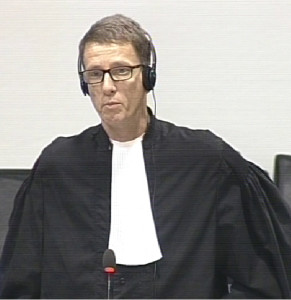
International Nuon Chea Defense Counsel Victor Koppe
He referred to another witness’s statement, who had indicated that Vietnamese refugees were arrested and that he did not consider that this was a good thing, but that the Khmer Rouge considered them as the “Hereditary Enemy.”[7] When Mr. de Wilde asked for a reaction to this quote, Mr. Koppe objected, explaining that the Prosecution used selective evidence. The objection was overruled. The witness said that he did not know.
When Mr. de Wilde referred to the testimony of the same witness, Mr. Voeun said that it had been “well-known” that the Vietnamese and the Cambodians had been enemies since before he was born.[8] He made a distinction between the Vietnamese who were armed and those “ordinary Yuon.” He explained that if he had considered them enemies, he would have directly smashed them when they arrested them. The upper level where he sent them to had the authority to deal with these people. This prompted Mr. de Wilde to refer to the witness interview, in which he had said that some people jumped into the water, and that they “eliminated the rest” of the people on the boats they intercepted.[9] Mr. de Wilde wanted to know what he meant that they “eliminated the rest”. Ms. Guissé objected again and said that he had to make a distinction between civilian and military boats. Mr. de Wilde corrected the reference and referred to the next answer. The witness answered that a civilian fishing boat fired upon them, in which case they “retaliated” and fired back. He recounted an incident where the witness’s boat had been sunk and they had to swim.
At this point, Mr. de Wilde asked for additional 15 minutes from the Chamber, which was granted. The President then adjourned the hearing for a break.
Arrests of Vietnamese
After the twenty-minute break, Mr. de Wilde resumed his line of questioning by referring to the witness DC-Cam statement. He had told DC-Cam that there were hundreds of people who were arrested.[10] Mr. de Wilde wanted to know whether he spoke about those who had been arrested in Koh Kong or whether we used it more general and also included people who had been intercepted in other areas. He said that this statement referred specifically to the people who might have been fleeing from Koh Tral. Mr. de Wilde wanted to know why it was necessary to arrest the refugees and civilians if he did not consider them enemies. He said that “of course it would not be possible for any foreign element to walk in a [sovereign] country” or to enter into the waters. These were the rules and regulations of every sovereign country. It was the Division 1 who arrested them.
Marriages
Mr. de Wilde wanted to know whether many of his soldiers were single and in age to be married. He confirmed this and said that some of them got married. Mr. de Wilde wanted to know whether marriages were encouraged within Division 1 by Ta Soeung, Ta Sy or someone else. He confirmed this. They would arrange marriages if they were around 20 years old. “Actually he brought some women from his office for those who intended to get married.”
Mr. de Wilde inquired whether he heard the Party wanted to quickly increase the population, in particular because Vietnam had a much bigger population. Mr. Voeun confirmed having heard this. The plan to marry people was related to this. He drew lists for people that were supposed to get married.
Mr. de Wilde wanted to know “how it was possible to marry those soldiers if there were no women close by”. Mr. Voeun said that the women were not brought in from Ta Sy’s office, but from a female unit that was attached to the unit nearby. Mr. Voeun explained that there were not enough women, but that it was “gradually organized”. He answered that he knew some of the women. With this, Mr. de Wilde finished his line of questioning and gave the floor to the Civil Party lawyers.
Capture of Phnom Penh
Civil Party Lawyer Lor Chunthy from Legal Aid Cambodia asked about the capture of Phnom Penh. Mr. Voeun recounted that Division 1 entered Phnom Penh from three locations. He received an order from the Division Secretary that Division 1 had to come from three different directions, coming from the North, East and West. However, there were “several spearheads”. After meeting other forces, his unit was instructed from Ta Mok (through Ta Soeung) to withdraw to the outskirts.
Mr. Chunthy backtracked to the withdrawal of the troops from Phnom Penh and asked about his testimony that he did not know about the order to evacuate Phnom Penh inhabitants. He wanted to know whether he saw those people leave the city and whether he had asked whether there were instructions to do so. Mr. Voeun recounted that he remained in the location where they withdrew to for around a week (he was unsure about this period), and they saw people leave the city. These people had told him that they were instructed by Angkar to leave the city. They had told him that they were not leaving the city voluntarily. “Some of them were walking, while others were driving their cars or were on rickshaws or push-carts.” It was likely that his division had held a meeting with other leaders, he said, and recounted that they determined that they had to achieve their “complete victory” by the 18th of April so that “the Yuon did not have time to counter our attack.”
Mr. Chunthy referred to another document and asked whether he was aware of the establishment of a Security Center near Prey Nhub.[11] He said that he was not aware of it in the beginning. He attended a meeting in Anlong Veng, which was part of Kampong Chhnang. Ta Sy, Ta Soeung and Pol Pot were present in that meeting.
Mr. Chunthy said that he had spoken about a congress in the West Zone and sought more detail about this congress.[12] He answered that there was a West Zone congress that was held at the Chankar Dong Coconut Plantation. He attended the congress and it lasted for around a week or a little bit more. The topic of this conference was rice production, amongst others.
Vietnamese refugees
The President intervened, said that the Civil Party lawyer had run out of time and gave the floor to the Khieu Samphan Defense Team.
Ms. Guissé asked about the alleged arrests of Vietnamese boats and asked whether she understood it properly that he had said that they did not encounter Vietnamese fishing boats but only Vietnamese refugees. Mr. de Wilde interjected and said that proper references should be given. Ms. Guissé said that she had only asked him whether this was correct or not. He said that he only encountered motorboats and not big ships. He never saw fishing boats, but only boats loading Vietnamese refugees.
She then inquired whether he remembered whether there were any negotiations about the refugees after handing the people to the headquarters. Mr. Voeun said that he sent them to the headquarters.
She referred to his interview and repeated her question whether he knew anything about negotiations for those people who had been arrested.[13] He replied that he had not received any information for that.
He confirmed that Ta Soeung was absent sometimes. Ms. Guissé then wanted to know whether Ta Soeung attended meetings in Phnom Penh during his absence. He answered that he had not told him and that he was advised to send his report to the headquarters. The orders to send the reports to the headquarters were issued by Ta Soeung.
She then wanted to know whether he knew of any conference in 1977 in Phnom Penh, during which Son Sen issued orders on how to treat Vietnamese in the territorial waters of Kampuchea. He replied that he never heard about it.
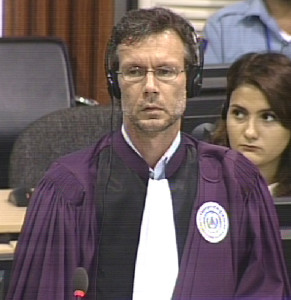
International Senior Assistant Prosecutor Vincent de Wilde
She said that a person had said that Son Sen had given instructions in a meeting not to arrest Vietnamese refugees.[14] He said that he had not heard about this. When Ms. Guissé asked whether it was correct that he never received instructions not to kill Vietnamese who travelled at sea, Mr.de Wilde objected to the question, arguing that the foundations of this questions were not well made. Ms. Guissé repeated her question. He answered that the order was to make a report to Ta Soeung, who would forward the report “up the line”, when they encountered Vietnamese at sea. He did not order to kill Vietnamese people to his subordinates either.
Ms. Guissé asked whether he heard Ta Soeung or any other person give such orders to shoot at Vietnamese civilians when they were in boats “of less than twenty”. Mr. de Wilde interjected and said that the other witness worked in Division 164 and not in Division 1. He said that he had never heard of such orders. He never received an order to kill Vietnamese people. He could communicate with Division 164 directly when being on the island. He again said that he had never heard about an order to shoot dead refugees on boats. “There was no such incident happening and no such order.”
Ms. Guissé then asked whether he heard of any other instructions regarding the treatment of the Vietnamese. He said that he only knew about the tasks that lay within his responsibility.
Ms. Guissé wanted to know when he heard about the arrest of his aunt and her husband that he had mentioned yesterday afternoon. He answered that when he arrived in Preah Vihear after having left Koh Kong, he travelled through his village and learned about this. This might have been in 1978. He could not remember the names of the village chiefs. He could only remember some of the chiefs in Sector 31 and 32. His aunt was called Kun. He did not know the exact circumstances of their arrests, but he knew that his aunt died while her husband returned to Hanoi. She had heard that she had a child and that her husband had returned to Vietnam. Vietnamese people were invited to return to their homeland in 1970.
Ms. Guissé asked whether it was correct that his aunt was arrested until 1978. He said that it was between 1970 and 1978. Ms. Guissé wanted to know whether it was correct that he heard about the arrest of his aunt before the fall of Phnom Penh. The witness said that it was after the fall of Phnom Penh. With this, Ms. Guissé finished her line of questioning.
The President thanked the witness, dismissed him, and adjourned the hearing for a break.
New Witness: In Yoeun
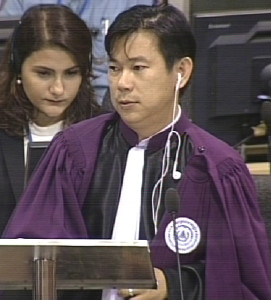
National Deputy Co-Prosecutor Srea Rattanak
After the break, the floor was given to the Co-Prosecutors to put questions to new witness In Yoeun. National Deputy Co-Prosecutor Srea Rattanak resumed his question from January 27 2016 by asking how old she was now. She replied that she is 56. He said that she had previously said she was 60 years old. She now said that she was 56 and not 60. She could not remember the year that she was born. She could not recall the event of 17 April 1975. However, she knew that Phnom Penh fell in 1975. She did not know how she was at the time. Mr. Rattanak asked her whether she was assigned to be part of the children or the youth unit. She said that she was in the mobile unit, since she “was full-fledged.” She was around fifteen years old.
Turning to the next topic, Mr. Rattanak wanted to know whether she could recall if there were any Vietnamese people living in her commune, which she denied. He asked whether she saw other Vietnamese people after the fall of Phnom Penh in other communes, which she also denied. When Mr. Rattanak pressed on, she said she saw them living close to the border when she worked in the mobile unit. “I was working in Dong location near the Vietnamese border. Members of mobile units were afraid of the Vietnamese, although we were living in different countries.” She confirmed that the Vietnamese people were living in another country. “We could not cross into Vietnam, and they could not cross into Cambodia either.”
Mr. Rattanak rephrased his question and asked whether she ever saw Vietnamese living and working in the location that she was assigned to work after the fall of Phnom Penh, which she denied: “I never saw Vietnamese people.”
To refresh her memory, he referred to her DC-Cam statement, in which she had stated that four Vietnamese families were sent away.[15] She replied that she could not recall it, “since it happened a long time ago”. She confirmed knowing Prey Chhor. It was located to the West of Chhrak. It was located in Chrey Commune. It was about five kilometers away from her residence. Her house was in Trak. It was both in Svay Rieng Province. He inquired whether Prey Chhor had “anything to do” with the Vietnamese people. She replied that she could not recall anything that happened.
Confusion: has In Yoeun been interviewed?
Mr. Rattanak referred to her interview and submitted that she had said that they had gone and disappeared after the Vietnamese went to Prey Chhor.[16] He asked who she was referring to. At this point, Nuon Chea Defense Counsel Victor Koppe said that the document the Prosecution was referring to was not from the witness, but might have been from the neighbor. Mr. de Wilde said that the person was identified as In Yoeun was the person who was interviewed by DC-Cam. To his understanding, there were two interviewees in the interview.[17] The President instructed the Co-Prosecutor to clarify the issue. Mr. Rattanak asked her whether she recalled being interviewed in 2005. She replied that it was her husband who was interviewed in 2005. “In fact, my husband wants to come to the court, but I don’t know how come I was summoned to come to the court.” She further said that: “My husband actually really wants to be here.” During the interview, she said, she had also said something, but there was also an old man who spoke. There was the old man, herself and the husband. There were also some children.
Mr. Rattanak said they would rely on the Chamber’s wisdom to decide whether it was the actual person. The President said that it was up to the Prosecution to clarify the matter. “And it would be really strange to call a neighbor to testify rather than the person who was interviewed.”
National Khieu Samphan Defense Counsel Kong Sam Onn said that the document mentioned a neighbor, and older man and other children who might have all said something. This, in his view, did not mean that all statements that were indicated as having been said be a neighbor were made by Ms. Yoeun.
Mr. de Wilde said that it seemed like the neighbor referred to in the DC-Cam statement was the witness and that they could confront her with these statement. He sought to clarify the issue and asked whether she spoke during the interview, which she could not remember. She said that Ysa Osman did ask her for her name.
Mr. de Wilde took over from his national counterpart and asked whether there was a distinction made between youths and children in the mobile units. She replied that there was a group for youths, one for children, and one for female children. Youths from the age of 15 onwards were able to be in the youth unit.
She said that the older youths were assigned to build dykes. Those who got married in the mobile units were sent to the cooperative once they got married. She said that the living conditions in the mobile units were harsher than the ones in the cooperative. They did not have enough food to eat in the mobile units. “Usually, we only ate part of the banana stalk and trunk.” Mr. de Wilde wanted to know whether some youths who volunteered to get married to move to the cooperative. She replied that this happened sometimes that people got married within the cooperatives.
She confirmed another statement she had made.[18] Mr. de Wilde said that this showed that the person who had spoken during the interview was her. He asked the witness whether there were ethnic Vietnamese girls or whose parents were mixed. She answered that there were Khmer soldiers who were members of the mobile unit who lived in the cooperative, but she did not see any Vietnamese soldiers.
Trying to find out more about the treatment of the Vietnamese
He read out an excerpt of the interview, in which the person had talked about the arrest of Vietnamese people.[19] She replied that she had forgotten it all and could not recall that.
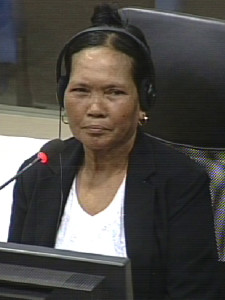
Witness In Yoeun
When Mr. de Wilde asked whether the person she had mentioned in the interview Ming Ngam was a member of the family. She denied that she had a relative by that name. At this point, Mr. Koppe interjected and said that it was now very clear that the person was not the person who was mentioned in the interview. He therefore requested the examination to stop. Ms. Guissé reminded the court of Rule 83 of the Internal Rules, in which it is laid down that the Co-Prosecution may examine a witness whose statement is deemed useful for the manifestation of the truth. Under these circumstances, she requested the examination to end now. Mr. de Wilde replied that he had posed other questions to manifest her identity first and that what she had said had been consistent with what the unidentified person in the DC-Cam statement had said.
International Civil Party Lead Co-Lawyer Marie Guiraud said that she would like to present another statement (E3/7816) to the witness. She intended to put questions to the witness regarding forced marriage.
After conferring with the bench, the President announced that they wanted to hear the testimony, but instructed the Co-Prosecution and Lead Co-Lawyers not to use the disputed DC-Cam statement.
Mr. de Wilde asked in general whether she knew what happened to those children who came from a mixed marriage. She said she did not know.
Prum Yan
Ms. Guiraud asked whether she knew someone called Prum Yan of her witness. She said that she knew this person. “That person walks past by my house almost every day.” This person had also said that he wanted to testify in front of the chamber. That person had suggested that she should not go but that he should go instead. She did not know the person Tep.
She read an excerpt of the interview given by Prum Yan.[20] He said that he saw a mixed-race Vietnamese woman whose husband was called Tep. Prum Yan had described an arrest. She answered that she had heard about it. “That person was half-blooded Chinese and was arrested and killed afterwards.” She was the wife of Kien Soeung, who was Khmer. Prum Yan had mentioned this. Ms. Guiraud said that she had referred to a half-blooded Vietnamese person that Prum Yan had mentioned. Ms. Yoeun replied that the person she referred to was half-blooded Chinese. This person was taken to Prey Chhor, but she did not know why or what happened to this person. Prum Yan told her this. The child was taken later after having been kept with the father first.
Ms. Guiraud asked whether she understood her testimony correctly that Prum Yan was interviewed at her house about this story. She replied that Prum Yan was also present at the house when her husband was interviewed.
The President announced that there had been an e-mail regarding the motion by Nuon Chea to admit documents in relation to the testimony of expert 2-TCE-95. He asked the parties whether the parties were able to make submissions regarding these motions. Both the Co-Prosecution and the Civil Party Lead Co-Lawyers said they would be ready to make submissions after the break. At this point, the President adjourned the hearing for a break.
Arranged Marriages
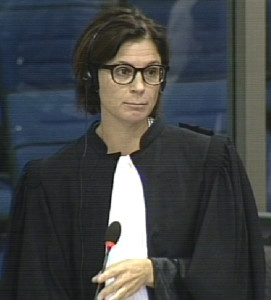
International Lead Co-Lawyer Marie Guiraud
At the beginning of the last session, Ms. Guiraud asked whether she got married between 1975 and 1979. She replied that she got married in late 1977. After her marriage, she moved to the cooperative and no longer in the mobile unit. She received more food at the cooperative. She knew her husband when she was in the mobile unit. Her husband was in the fishing unit. There were many couples who were organized to get married in late and early 1977. Asked about how she felt during her marriage, she said that she did not know her husband “clearly” when she was getting married, but she followed the orders of Angkar. She could not refuse to marry her husband, regardless of whether she loved her husband or not. No one refused to get married. “Everyone followed the order when Angkar instructed them to get married.” There were many couples, who were all sent to cooperatives afterwards. She did not dare to refuse, since she was afraid of being taken to Svay B’tom. She said that she had heard that couples who refused to get married would be taken there. They would be re-educated at the commune office first and then taken to Svay B’tom. She did not know the person who presided over the wedding ceremony, and that person did not tell them his or her name. She only knew that the person worked at the commune office. They did not spend the first night together, since she went to her parent’s house and he went to his parent’s house.
Ms. Guiraud wanted to know whether there was an obligation to consummate the marriage, which the witness confirmed. If they did not consummate the marriage, “We would be taken to the commune office to make sure we consummated it there.” They said that they had to fulfill their “marriage obligations” before being sent to the West. If they refused to follow the instructions, they would be killed, even if doing so meant to “lose the honor.” When she was sent to the West, she was three months pregnant. She arrived at Teu Ang, where she was sick. This is why she was sent back. She told the people that she needed to urinate, which her husband also told the people. Instead of relieving herself, she went back. She “ran across the forest” to go back. When it was nightmare, she did not dare to sleep in the village. Her mother shared her food rations with her, since she did not have food herself. Later, the Vietnamese arrived and they were liberated.
She took an oath during the wedding, stating that she would commit to her husband her whole life.
At this point, Ms. Guiraud finished her line of question and the floor was granted to the Nuon Chea Defense Team. Mr. Koppe asked whether she was still married to the same person as in 1977, which she confirmed. She has four children.
Back to Prum Yan
Prum Yan had told her that if she came to the Court, she would not be able to give details, but if he went to the Court, he would be able to give details. Mr. Koppe wanted to know whether she heard the story about the mixed Khmer-Chinese couple when Prum Yan was interviewed her house or whether she had heard this before. At this point, Mr. de Wilde interjected and said that it seemed like the defense team suggested that she was assisted when she was interviewed in the house. Ms. Yoeun had said talked about a story of a Chinese-Khmer person and not by about a Vietnamese-Khmer person, which Prum Yan had talked about. Ms. Yoeun recounted that Prum Yan had talked about the “mixed-blood Chinese woman.” She said that Prum Yan was present in the interview. She could not recall whether this was the first or second time that she heard the story. She could not recall who were the interviewers and how many interviewers participated. Mr. Koppe wanted to know whether Prum Yan had talked about the Khmer Sar movement, led by So Phal. She replied that she only knew about the White Khmer movement when Ta Yan told her about it.
Mr. Koppe referred to another document, in which an incident was mentioned about resistance movements.[21] Mr. de Wilde interjected and said that the question had nothing to do with the witness’s personal story. Mr. Koppe rephrased and asked whether she had heard about the Vietnamese attacks in her district in 1976. She said that there was shelling to the east of her worksite. This happened once every month or every two months.
At this point, the floor was granted to the Defense Team for Khieu Samphan. She asked whether she understood her testimony properly that the people who had married and subsequently sent to cooperatives had better living conditions, which the witness confirmed. Those who were in the mobile unit did not have sufficient food. She confirmed that she volunteered to get married so that she would work in the cooperative. “Although I did not love the one that I was to get married to, I decided to accept the marriage.” With this, Ms. Guissé finished her examination of the witness. The President thanked the witness and dismissed her. He then announced that submissions would be heard regarding the Nuon Chea Defense Team motions. The floor was granted to the Defense Team for Nuon Chea to provide reasons for their request.
Submissions regarding two motions by Nuon Chea Defense Counsel
Mr. Koppe said that he just briefly wanted to clarify that one document had already been admitted (Philip Short’s Phnom Penh’s Post Article – Devil’s Advocate E367/4.1.8). He explained that “filing a request earlier doesn’t necessarily lead to an earlier decision”. Despite admitting that the request was late, he argued that there were sufficient reasons why these documents should be admitted.
International Co-Prosecutor Nicholas Koumjian announced that he was at a disadvantage, since he had not been able to read through all of them. He then objected to the majority of documents, with the exception of a few.[22] Mr. Koumjian objected to the rest of the documents based on grounds of irrelevance to the segment[23], because they expressed personal opinions of authors that were not necessarily legally trained on legal issues without giving factual evidence[24], and because they were S-21 confessions.[25] The documents included newspaper articles, scholar articles and pieces by experts.
Civil Party Lead Co-Lawyer stated that she would rely on the chamber’s wisdom, with the exception of the S-21 which needed to be rejected.
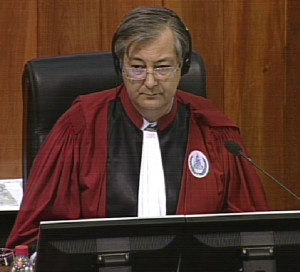
Judge Jean-Marc Lavergne
Judge Jean-Marrc Lavergne asked why he wanted S-21 confessions to be admitted. Mr. Koppe explained that many S-21 confessions were part of the case file, which was nothing unusual. They had requested these two to be admitted, since the expert witness had based a substantial part of his information on S-21 confessions. He further said that the confessions should be translated, since they were only available in Khmer so far. They had not requested a translation yet. Neither had they requested the translation of those documents that were only available in English.
Ms. Guissé said that they would rely on the Chamber’s wisdom.
Mr. Koppe had three remarks:
- Despite not being able to use other scholar’s definition of genocide, some articles would add to balance the discussion.
- The relevance of the documents relating to the Cham official was that they could establish a connection between FURO and the Cham official
- In the form of a question: Will the Chamber allow the Defense leeway to ask questions to the expert in how he has conducted interviews in case 004? For example, there had been stark discrepancy between what a witness had said in closed session last week and what she had said in interview. Mr. Koppe wanted to ask the expert how he had asked the questions.
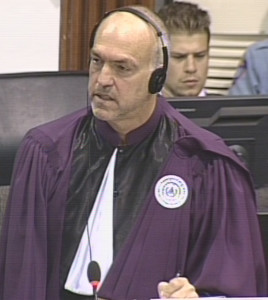
International Co-Prosecutor Nicholas Koumjian
Mr. Koumjian responded that the witness had been called as an expert in the Cham segment. The Chamber had to make it clear that this was not a witness as to OCIJ procedures. Counsel was certainly entitled to bring out different understanding of genocides, but the opinions about legal definitions should not be included, since this was up to the Chamber.
Ms. Guiraud stated that Ysa Osman was not here to testify about Case 004.
Mr. Koppe said that Ouk Bunchhoeun referred to 1975, which was when S-21 had not existed yet and that the documents should be admitted.
The President announced that the hearing was now adjourned and would resume on Monday, February 08 2016. Thus, there is no hearing tomorrow, February 4 2016.
[1] Testimony of Meas Soeun, February 02 2016, at 15:59:04.
[2] Testimony of Meas Soeun, February 02 2016, at 15:58:04.
[3] E3/73, at answer 76.
[4] E3/1094, July 1978.
[5] E3/1094, at 00593530 (FR), 00143610 (KH), 00315374 (EN).
[6] Ibid., p. 1 (EN), p. 1 (FR), pp. 1-2 (KH).
[7] E319/23.3.44, at answers 31-33.
[8] E1/369.1.
[9] E319/23.3.32, at answer 8.
[10] E3/5872, p. 28 in Khmer.
[11] E3/73.
[12] E3/80, answer 16.
[13] E3/8752, 00849511 (EN) 00733340 (KH).
[14] E319/23.3.12, answer 75.
[15] E3/7525, at 00089629 (KH), 00903085 (FR), 00885015 (EN).
[16] E3/7525, at 00089590 (KH) 00903083 (FR).
[17] E3/7525, p. 46 00903087 (FR), 00405016 (EN).
[18] E3/7525, at p. 26 (EN), 00903069 (FR), 00884999 (EN), 00089612-13 (KH).
[19] E3/7525, at 00903085 (FR), 00885014-15 (EN), 00089628-30 (KH).
[20] E3/7816, at question 1, 00339874 (FR), 00277223 (KH)m 00282938 (EN).
[21] E3/1132, at 00548772 (EN), 00807139 (FR), 00160076 (KH).
[22] Motion 1 documents that the OCP did not object to: Attachment 1 (E367/4.1.1, interview with expert witness); Attachment 3 (list of witnesses the expert had interviewed in his capacity at the OCIJ; depending on the intended use); Attachment 4 (document offered by witness); Attachment 6 (Bulletin of Concerned Asian Scholars); Attachment 7 (comment on number of Cham who were killed); Attachment 12; Attachment 14 (statement of the witness)
Motion 2 documents that the OCP did not object to: Attachment 3 (The Long Cham Tragedy History).
[23] Motion 1: Attachment 2; Attachment 15; Motion 2: Attachment 4; Attachment 5; Attachment 6; Attachment 7; Attachment 8; Attachment 9; Attachment 10; Attachment 11; Attachment 12; Attachment 13; Attachment 14.
[24] Motion 1: Attachment 5; Attachment 8; Attachment 9; Attachment 10, Attachment 11, Attachment 13.
[25] Motion 2: Attachment 1 and 2.
Featured Image: Witness In Yoeun (ECCC: Flickr)
